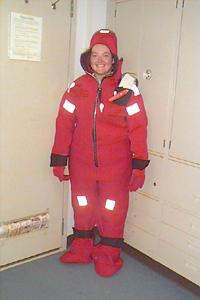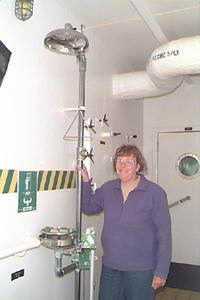| |
Teacher
Logbook:
Saturday, July 29, 2000
During our last safety drill it was suggested that we try on our Survival
Suits. If we had to abandon the ship we wouldn't survive the cold Pacific
Ocean water without this one-piece special suit. The suit is made of a
very thick wet suit type of material. As you can see from the picture,
it zips up the front and cinch straps are used to tighten the suit at
the ankles, wrists and under the chin. An inflatable head support, with
an attached inflation tube, can be inflated by mouth. The head support
keeps your head above water even if you are unconscious. A cord attaches
a whistle to the front zipper to signal your location. The suit has a
flashlight on one shoulder and reflective tape to make someone in the
water easier to find. In just the short time we had the suit on we became
very hot.
The other piece of safety
equipment that we checked out was the safety shower/eye wash unit. Several
of these units can be found throughout the ship. The showers and eyewashes
are used for chemical spills or clothing fires if necessary. Our picture
is of an outside unit, but there are also several units inside. Other
pieces of safety equipment include large carbon dioxide fire extinguishers
for electrical fires and dry chemical fire extinguishers to smother other
fires. In case of smoke, Breathing Apparatus tanks and fire fighting suits
are available throughout the ship. There are special damage control lockers
with special tools and meters for checking for harmful gases, and shoring
tools to repair any hull damage on a temporary basis. What are the little
hinged doors at the bottom of every hallway door? In case of fire, the
fire hose is fed through the small, hinged door. This prevents smoke from
traveling from one place to another and lets less air circulate into a
burning area.
|
|

Mary Beth in her survival suit (not the easiest thing to get around in).

Carol at one of the safety
showers available throughout the ship.
|
|

